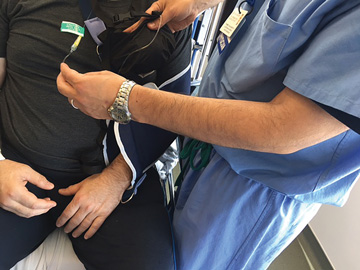Dr. Finneran uses pain pumps to place about 1,000 continuous peripheral nerve blocks a year. “We can provide really good pain relief after surgery,” he says. “The longest-acting numbing medicine we have is bupivacaine, which
only lasts 12 to 24 hours, depending on where you put it. Surgical pain lasts much longer than that.”
Electronic pumps let Dr. Finneran combine automated boluses with patient-controlled boluses, a feature he says is key. “Giving patients boluses of local anesthetic is nice, but if you only have patients controlling their boluses, and
they forget to do it or fall asleep, it can lead to a lot of pain that’s difficult to get back under control,” he says. “With automated boluses, you can take advantage of that extra spread of local anesthetic while not
relying on the patient to self-administer the medication.”
He says electronic pumps are not challenging for most patients to use. “The pumps administer the medication automatically, either as a continuous infusion or as automated boluses, and patients can push a button if they want to give themselves
an extra dose,” says Dr. Finneran.
Patients’ main concern about the devices is removing the catheter. “Most patients assume they need to schedule a follow-up appointment to have it removed,” he says. “Really, it’s just secured in with a tape-like
dressing, and when you peel it off, it just falls out.” In terms of potential complications, Dr. Finneran says connections can become kinked or tubing can catch on something and become disconnected. On rare occasions, pumps will
malfunction and need to be reset — ideally by a nurse who can walk patients through the resetting process.
Dr. Finneran and colleagues recently conducted a study about pain pumps that is under final review. “We compared automated boluses to continuous infusion for popliteal sciatic catheters for pain control after foot and ankle surgery,”
he says. They found that patients with preprogrammed automated boluses needed fewer total doses of local anesthetic, which was provided in a 500-mililiter reservoir — the largest amount he and his colleagues usually give patients.
“We thought that by giving patients doses of long-lasting numbing medicine spread out in such a way that the basal dosing was less, we could potentially extend their pain relief by prolonging the infusion,” he says. “Interestingly,
we found those patients also had better pain control. Their pain scores were lower, their opioid consumption was lower and the drug lasted longer.”
Providers who are tempted to provide more than 500 milliliters of anesthetic should keep the weight of the reservoir in mind. “Patients are connected to it, and they need to be able to move around,” says Dr. Finneran. “Any
more than 500 milliliters is quite cumbersome to carry in a fanny pack, especially when you factor in the weight of the pump and the tubing.”
Infusion dosages and timing depend on the procedure. “Femoral nerve catheters, which an ASC might provide after an ACL repair, have a very low dosing requirement,” says Dr. Finneran. “We set the pump to administer four milliliters
per hour, with a four-milliliter patient-controlled bolus available every 30 minutes. Brachial plexus catheters require more local anesthetic, so we set the pump to deliver eight milliliters per hour.”
Some electronic pumps can collect user data, which can be viewed in real time or collected and analyzed for process improvement purposes. “Many manufacturers now offer electronic dashboards where you can monitor the recoveries of individual
patients and get their feedback,” says Dr. Gadsden. “You can see that a patient has been pressing their button a lot to give themselves a bolus, which means they’re probably hurting more than you want. That’s a
time to give them a call to see if you can effectively tweak their treatment over the phone.” OSM
.svg?sfvrsn=be606e78_3)

.svg?sfvrsn=56b2f850_5)